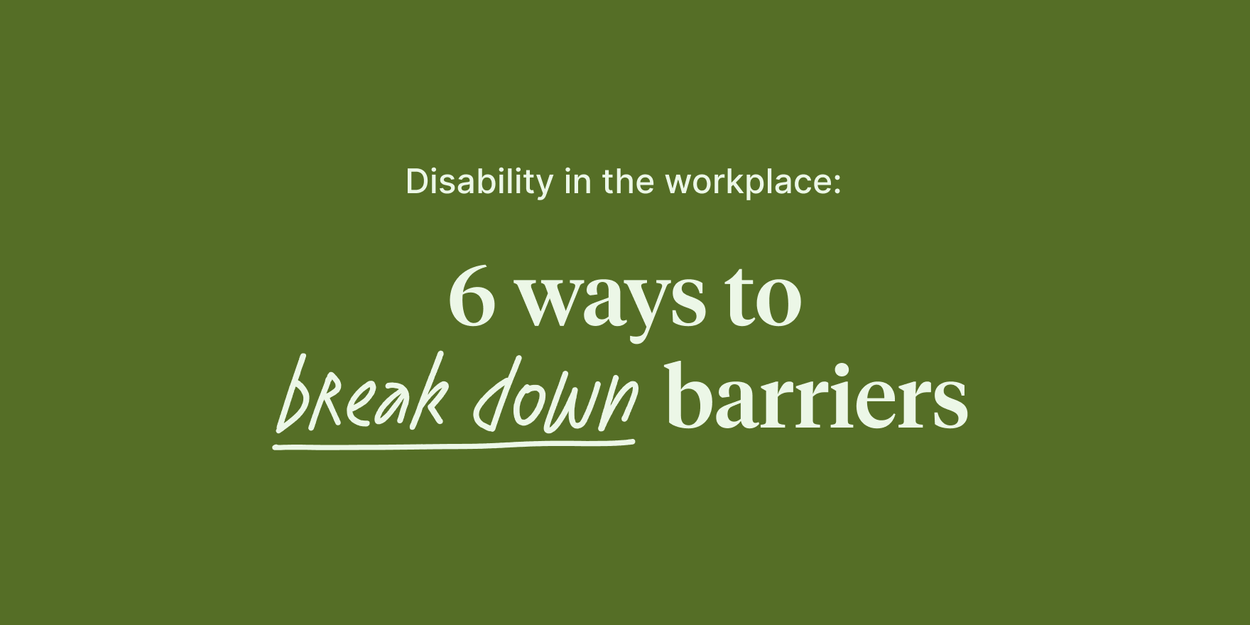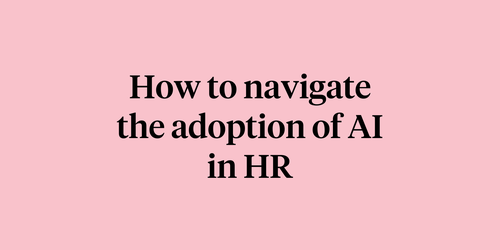
Disability in the workplace: 6 ways to break down barriers

Written by

Senior Content Marketing Manager, Culture Amp
Folks with disabilities face numerous barriers across the employee lifecycle – from getting an interview to overcoming biases in the hiring process, securing reasonable accommodations, and more.
Almost half (47.5%) of all folks with disabilities who were not working in June 2019 reported at least one barrier to employment, according to the U.S. Bureau of Labor Statistics. And although this is 2% lower than when this data was last collected in 2012, it’s still an alarmingly high number. Fortunately, we can all take action and drive this number down.
In the first part of our disability series, we established the benefits of disability inclusion in the workplace. In the second part, we took a deep dive into how ableism creates barriers for folks with disabilities. In this third and final installment, we’ll explore how individuals and organizations can play their part in breaking down those barriers.
Building a better world of work for the disability community
Awareness and education is just the first step to building a better world of work for the disability community. It’s time to turn our commitments and values into actions that can improve the experiences of folks living with disabilities.
Below are six ways to break down barriers in the workplace according to Ola Ojewumi and Regina Walton.
It’s important to note that this list isn’t exhaustive, nor is it ordered in any particular way. Folks with disabilities face a numerous set of barriers. What is most impactful will range from person to person, and from organization to organization.
1.) Create a culture where employees feel safe to disclose their disability
By being open about her disability, Regina has been able to seek reasonable accommodations for her diabetes. She explains, “I think the tension with the companies that I've worked with has been mitigated a lot by just standing up for myself and being assertive about having an endocrine disorder, how I treat it, and how I need just a certain amount of leeway to take care of myself.”
However, for many employees with hidden disabilities, it can feel challenging, or even impossible to disclose one’s disability status. A report by the Center for Talent Innovation found that although 30% of employees met the federal definition of having a disability in 2016, only 3.2% disclosed this disability to their employers.
Yet, disclosure provides powerful benefits for both the individual and the organization. The same report by the Center for Talent Innovation found that people who disclose their disabilities are more than twice as likely to feel regularly happy or content at work as those who have not disclosed. Disclosure also grants employees protection against discrimination under ADA, as well as the legal right to seek reasonable accommodations that can improve productivity and the overall work experience.
Be very clear when people are coming into the organization from onboarding onwards that disclosure is not necessary, but it’s okay and preferred. But you have to really model it and believe it because you can say there’s no bias, but if a person discloses and there is some actual blowback, that is an awful, awful experience.
Regina Walton
Program Operations at Reforge
“Be very clear when people are coming into the organization from onboarding onwards that disclosure is not necessary, but it’s okay and preferred,” suggests Regina, “But you have to really model it and believe it because you can say there’s no bias, but if a person discloses and there is some actual blowback, that is an awful, awful experience.”
So although organizations cannot expect, much less (illegally) demand that employees disclose their disability status, organizations can create a genuinely supportive workplace culture and establish robust protections and policies for accommodation. That way, employees with disabilities will feel safe to disclose their disability status—but only when and if they choose to.
2.) Hire more folks with disabilities, especially for leadership positions
While 57% of respondents to the 2017 Kessler Foundation National Employment and Diversity Survey reported having diversity hiring goals, only 28% of respondents had goals for hiring people with disabilities. This number is disappointing, but it’s also a number that organizations have the agency to change.
“Specifically reach out to different disability rights organizations and organize ways in which people with disabilities can apply for work,” advises Ola. “Intentionally using Affirmative Action to aid in the hiring of people with disabilities is a huge deal.”
However, to be meaningful, these goals have to be more than just a numbers game. Don’t hire somebody with a disability, but keep them stranded in jobs without leadership opportunities. “[People with disabilities] have been relegated to jobs that don't require don't require us to lead others,” explains Ola. “Incorporating more people with disabilities into leadership positions and recruiting more people with disabilities in the workforce are the first steps to creating a more accessible world.”
3.) Equip managers with tools and resources to support individual needs
Working with poorly equipped or ineffective managers is an experience most people are familiar with. “A lot of companies will just promote people to managerial roles and don’t train them very well,” explains Regina. “It would be optimal for companies to prioritize training their managers and making sure they are ready to handle these types of situations [where they have to work and support direct reports with disabilities].”
In general, managers, like most folks, are most comfortable with people who are similar to them. As a result of this unconscious bias, managers may feel reluctant or daunted by the possibility of managing somebody with a disability. This is especially true because many managers haven’t encountered, much less worked with somebody who openly shares their disability.
Providing training, support, and resources is essential for easing such fears and preemptively addressing any potential biases that could arise in the manager-direct report relationship. For example, Disability:IN offers a free disability fundamentals training for managers. Organizations can also bring in (and pay) disability advocates, advisors, and activists to help train and educate their workforce.
4.) Create an ERG for employees with disabilities
“Create an ERG for people with disabilities to find each other and band together to help each other,” suggests Regina. “Organizations are not perfect, people are not perfect. And maybe if you have a core of people within your organization who are working on this, then they can surface areas where the organization falls short.”
Creating and supporting ERGs (employee resource groups) is one way companies can promote belonging and create safe spaces for employees from historically marginalized groups. As ERGs are employee-led, strongly consider paying your ERG leaders and integrating the work they do into their job description.
5.) Make accommodation and accessibility a priority
As discussed in the second blog, whether or not a workplace is accessible or offers accommodations can be the sole deciding factor in whether or not somebody with a disability can access certain employment and work opportunities.
It’s also important to know that accessibility and accommodations are not the same things. Here’s how they’re different:
- Accommodations are modifications or changes made reactively for an individual with a disability on an as-needed basis. They’re sometimes likened to “patches” or “quick fixes.” Examples include assistive technology like screen readers, raised or adjustable height desks for employees that use wheelchairs, and sign language interpreters.
- Accessible environments, tools, and experiences proactively provide equal access for everyone. An accessible space is sometimes thought of as a space where “accommodations” are integrated thoroughly and are thus always open and welcoming to society as a whole. Examples include ramps, automatic doors, elevators, and reserved parking spaces for folks with disabilities.
Both are important for creating a more inclusive and equitable workspace for employees with disabilities. Of particular interest lately is remote work, which has become increasingly common since the pandemic.
“With the increased ability to telework, attend classes remotely, schedule telehealth visits, engage in online social opportunities, and order groceries and prescriptions delivered to their doorstep, individuals with disabilities are now widely accommodated in ways that previously seemed impossible,” explains Brandy L. Wagstaff and Jacob Quasius. “But now, employers are withdrawing telework and forcing people to come back to work, which is a huge barrier for people with disabilities,” reflects Ola.
So if your organization is looking to truly embed disability accessibility and inclusion into your workplace, remote work is an easy and effective option. Flexibility is beneficial for all employees, but for the disability community, it may mean the difference between having a job, and having to give up on a job.
6.) Be an advocate and ally for the disability community
Individuals without disabilities play an important part in making the workplace a more fair and equitable place for people in the disability community.
If you see something, say something. if you see discrimination or that a person is not getting a reasonable accommodation, speak up for them, speak up with them, and stand with them as opposed to letting them stand alone.
Ola Ojewumi
Founder of Project Ascend
“If you see something, say something,” says Ola. “if you see discrimination or that a person is not getting a reasonable accommodation, speak up for them, speak up with them, and stand with them as opposed to letting them stand alone.”
In other words, turn your commitment to disability inclusion and DEI into action. Self-education is a start, but knowledge provides few tangible benefits for the community in question. If you observe a microaggression, say something. If somebody makes an ableist joke, tell them you don’t find it funny. If there are no wheelchair ramps or elevators, bring it up with the organization and demand change. Progress can be difficult, but people with disabilities shouldn’t have to go it alone.

HR’s complete guide to DEI
Get everything you need to know about DEI, including best practices and resources for both getting started and evolving your approach.

